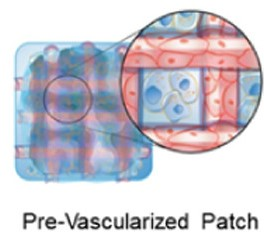Oct 29 2020
In the past few years, heart disease has been the major cause of death around the world, reports the American Heart Association.
 A cardiac cell patch combines an engineered blood vessel network (red) with human cardiac stromal cells (blue) in a 3D fibrin matrix, as seen in this artist’s rendition. Image Credit: Adapted from ACS Biomaterials Science & Engineering 2020.
A cardiac cell patch combines an engineered blood vessel network (red) with human cardiac stromal cells (blue) in a 3D fibrin matrix, as seen in this artist’s rendition. Image Credit: Adapted from ACS Biomaterials Science & Engineering 2020.
When a heart attack, or myocardial infarction (MI), occurs, a blocked artery and the consequent oxygen deprivation result in extensive cardiac cell death, inflammation, as well as blood vessel impairment.
Scientists have now reported in ACS Biomaterials Science & Engineering about a new cardiac patch with small, engineered blood vessels that enhanced recovery from MI in rats and pigs.
For the effective treatment of MI, it is essential for the lost heart muscle tissue to rejuvenate and new blood vessels to develop, so that supply of oxygen and nutrients to cells is restored. Researchers have made attempts to develop patches consisting of several therapeutic cells to treat MI. However, to date, such patches have been too challenging to create, or do not restore both cardiac muscle and blood supply to the damaged site.
Earlier, Ke Cheng and his collaborators developed a comparatively simple pre-vascularized cardiac patch, which included engineered microvessels contained in a fibrin gel fortified with cardiac stromal cells.
When the patch is implanted into rats following an MI, the cells secreted growth factors that were responsible for the regrowth of blood vessels and cardiac muscle. The researchers wished to further test the patch in rats and pigs, the cardiovascular systems of which are more similar to humans than those of rodents.
The team implanted the cardiac patch in rats that experienced a heart attack very recently. After four weeks, rats implanted with the patch exhibited increased cardiac muscle, less scar tissue, and improved cardiac pump function than untreated rats.
The researchers noticed similar impacts in pigs that had experienced MI and were treated using the patches. The patch enhanced the recruitment of the progenitor cells in the pigs to the injured area while increasing the growth of new blood vessels, reducing cardiac cell death, and suppressing inflammation.
Blood vessel-forming cells or natural blood vessels were used in previous studies to vascularize cardiac patches, but this study is the first one to show the success of pre-vascularized cardiac stromal cell patches by making use of micro-engineered synthetic blood vessels to treat MI in a huge animal model.
According to the team, additional studies are required on the safety, efficacy, and mechanisms of patch repair before applying the technology to humans.
This study was funded by the National Institutes of Health, the American Heart Association, the National Science Foundation, the North Carolina State University Chancellor’s Innovation Fund, and the University of North Carolina General Assembly Research Opportunities Initiative.
Journal Reference:
Su, T., et al. (2020) Cardiac Stromal Cell Patch Integrated with Engineered Microvessels Improves Recovery from Myocardial Infarction in Rats and Pigs. ACS Biomaterials Science & Engineering. doi.org/10.1021/acsbiomaterials.0c00942.